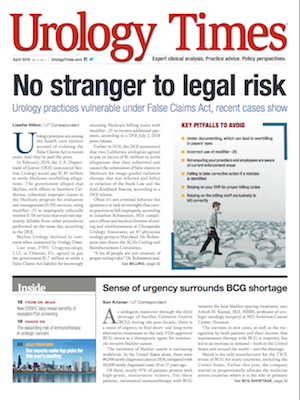Publication
Article
Urology Times Journal
Failure to consult urologist at heart of case
Author(s):
"The expert concluded that… had a urologist been consulted, additional attempts at placing a Foley catheter using a guidewire would have been made in an effort to relieve the retention," writes Acacia Brush Perko, Esq.
A 56-year-old male retired truck driver presented to the ER with a chief complaint of fever, chills, and body aches for 2 days. His prior medical history was positive for a urethral stricture for which he began receiving treatment when he was 24.
Prior to his urethral injury, the patient underwent several procedures to dilate his urethra and had been seen in the ER on numerous occasions for urinary tract infections. On presentation to the hospital, he reported to the ER physician that he had had trouble catheterizing himself at home. The ER nursing staff made several attempts to catheterize the patient, but to no avail. A urologist was consulted, who recommended that if the patient was able to void, there was no need to place a catheter in the ER.
The patient was subsequently given IV fluid and was able to void; however, he began to demonstrate tachycardia and hypotension. An internal medicine doctor then admitted the patient for a suspected UTI and to rule out sepsis. Urine and blood cultures were ordered and the patient was started on antibiotics for possible sepsis.
Also by Acacia Brush Perko, Esq.: Undetected kidney tumor leads to lawsuit
The man was seen for the first time by the internal medicine doctor the day after his admission. After testing, the patient was discharged 4 days later with instructions to continue on his antibiotic therapy for 7 days and follow up with his primary care physician. Later that day, the patient presented to the ER again with a chief complaint of hematuria and difficulty voiding. He was advised to make an appointment with a urologist.
Soon after, the patient was seen by a urologist. The urologist attempted to perform a cystoscopy, but he was unable to pass the scope beyond the stricture due to the presence of multiple false passages. The urologist opted to place a suprapubic catheter under general anesthesia. The plan was to leave the suprapubic catheter in place as long as necessary to allow for decreased swelling and healing of the urethra.
The patient later sued the hospital, the internal medicine physician, and nursing staff. The case proceeded to trial against the internal medicine doctor only.
Next:"The plaintiff claimed that because of the defendant-doctor’s negligence, he had to undergo placement of a suprapubic catheter, which remained in place for 7 months"The plaintiff claimed that because of the defendant-doctor’s negligence, he had to undergo placement of a suprapubic catheter, which remained in place for 7 months. He claimed that he presented to the ER with a chief complaint of a UTI and did not request to be catheterized. He argued that because of the multiple attempts at catheterizing him in the ER, he suffered injury to his urethra.
Plaintiff’s expert internist opined that the defendant fell below the standard of care due to his failure to be aware of the nature and extent of the urethral injury the plaintiff had suffered by the time he was admitted. The expert found that the defendant failed to adequately take a history of the urethral injury and did not perform a genitourinary exam at any time during the plaintiff’s hospital stay, negligently failed to request a consultation with a urologist while the plaintiff was an inpatient, and at discharge did not refer the plaintiff to a urologist.
Plaintiff’s expert urologist testified that the failure to consult a urologist while the plaintiff was an inpatient resulted in a lost opportunity to avoid suprapubic catheter placement. The expert noted that, due to the urethral injury, the plaintiff was not voiding well.
The expert concluded that the defendant’s opinion regarding urinary retention was supported by the findings of the renal ultrasound, which revealed a distended bladder, and had a urologist been consulted, additional attempts at placing a Foley catheter using a guidewire would have been made in an effort to relieve the retention and thereby avoid the need for the suprapubic catheter that remained in place for 7 months.
Read: Positional injuries pose medicolegal risks
The defendant claimed that his inpatient care and treatment of the plaintiff was well within the standard of care and that nothing he did or failed to do caused the need for the suprapubic catheter placement.
The defense’s expert internist opined that the defendant complied with the standard of care throughout the plaintiff’s hospitalization. The expert proffered that the primary reason for hospital admission was a life-threatening UTI that was adequately treated, and that the standard of care did not require a urology consult under the circumstances because any further catheterization attempts would have been contraindicative due to the plaintiff’s serious infection.
The defense’s urologist opined that the plaintiff had a chronic problem with a urethral stricture. The expert concluded that nothing that the defendant did or failed to do caused the need for the suprapubic catheter. In addition, on exam 3 years after discharge, the plaintiff had no residual problem with his ability to urinate.
Following a 7-day jury trial, the jury deliberated for 1.75 days. Ultimately, the jury returned a defense verdict, finding that although the defendant-doctor was negligent, his negligence did not cause the plaintiff harm.
LEGAL PERSPECTIVE: To succeed in a malpractice claim, a plaintiff must establish, by the greater weight of the evidence, both negligence and causation. In this case, plaintiff succeeded on establishing the defendant-doctor’s negligence, but failed to establish causation by the greater weight of the evidence.



















